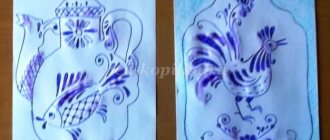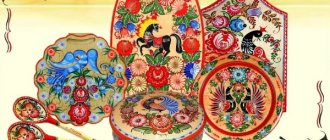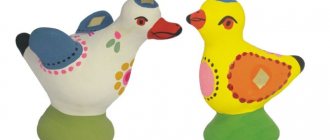One of the oldest crafts of arts and crafts in Russia is Khokhloma painting. For more than three hundred years, craftsmen have been making incredibly beautiful dishes, which can already be called the calling card of the Russian people. The process of creating a masterpiece is quite complex; it includes both the creation of blanks and their processing, as well as further painting. But anyone can master this skill; you just need to learn about the characteristic features of the creative process.
One of the oldest crafts of arts and crafts in Russia is Khokhloma painting
Khokhloma painting: patterns for beginners
It is customary to apply complex ornaments to products using a stencil, which can be purchased or printed, but in order to learn this type of painting, you need to master the basics. The simplest patterns are applied with a brush.
Beginners should first master the following:
- blade of grass The pattern is a sideways curved line. The brush is pressed in the center, and pressure is kept to a minimum from the edges. There is a smooth but strong thickening;
- curl. The element is more complex. The brush is applied with the same degree of pressure, and the line should be curled like a snail;
- droplet. Ideal for pressing training. In this case, the brush must be placed with the base of the bristles and rotated 180 degrees, slowly removing it from the surface and pulling it forward;
- bush. The droplets are drawn in the form of a fan, and a small dot is placed at their base;
- leaf Drawing this pattern is quite simple. You just need to draw out the blades of grass in a mirror image, bending them outward, and fill the void inside with paint of a similar color.
History of the fishery
There are many legends about how the famous Khokhloma craft originated. The first written historical mentions of the village of Khokhloma date back to the sixteenth century.
Origin - beginning of the 17th century
Even under Tsar Ivan Vasilyevich they knew about the place “Khokhlomskaya Ukhozheya” (Ukhozheya is land cleared of forest, prepared for arable land (obsolete)). The land was infertile. Peasants have long earned their livelihood by carving simple wooden utensils - spoons, pots, bowls, kvass and jugs in the form of birds, boats (ships) and animals. The products were unpainted and coated with drying oil for strength.
Some peasants went to work. Many went to the Trinity-Sergius Lavra, to which the Volga lands and villages were “assigned”. There, craftsmen painted wooden mugs and ladles, gilded cups, served on patronal feasts with gold and cinnabar.
At the beginning of the seventeenth century, Old Believers fled to the Trans-Volga forests, who began to be called “Kerzhaks”. They did not accept the patriarch’s decree, and settled throughout vast Siberia, in the forests of the Trans-Urals. Many settled in the impenetrable thickets of the Volga region. The schismatics brought with them icons, ancient letters, books, and utensils. Among them were icon painters who knew many of the secrets of painting. To survive in harsh lands, they began to decorate wooden utensils.
And simple kitchen utensils from Khokhloma blossomed with beautiful patterns that did not leave a single person indifferent.
Khokhloma in the USSR
Khokhloma production survived the collapse of Tsarist Russia, fell into decline many times and was revived again. After the collapse of the USSR, many workshops stopped working. In modern Russia there are two main production centers - the city of Semenov - the capital of golden Khokhloma, with the Semenovskaya Painting factory and the Khokhloma Painting enterprise. And also the village of Seminos and the production of “Khokhloma Artist”.
In the seventies, masters were invited to Kursk for training. This is how the famous Kursk hand painting was born. At first, the masters painted according to samples, and then their unique features appeared - a green background, a golden border. The rich ornaments of Sujan carpets were embodied in paintings with poppies and wildflowers. Interesting ideas arose for making vases and sugar bowls in the shape of ducks and cockerels.
Painting in blue and cyan on a silver background - a creative discovery of masters from Vologda, began to be called “Northern Khokhloma”. In her drawings with traditional grass, northern berries appear - blueberries, cranberries.
Gallery: Khokhloma painting (25 photos)
Purchasing materials
Choose the right base. The shape can be round, rectangular, square, or complex carved. It is better if the board has a hole to hang it on a nail or hook. Avoid using plywood or untreated wood. The surface for applying the pattern must be smooth, without depressions, notches and burrs. The easiest way is to buy a high-quality base at a craft store. If this is not possible, but there is a board ready to size, properly treat the surface with sandpaper. If this is not done, all the unevenness will remain after applying the paint. They can interfere with the perception of the drawing and will interfere with drawing.
Elements of Khokhloma for preschool children: step-by-step templates
Even a small child can create a Khokhlo pattern with his own hands, having mastered basic skills . Children's drawings have always been valued and pleased the eyes of parents. Often, an activity such as applique is carried out in the senior or preparatory group of a kindergarten. To create a pattern, it is enough to make a stamp from a tube and paper into which the paint will be dipped. Smaller elements are already painted with a brush, as in the pictures.
Even a small child can create a Khokhlo pattern with his own hands, having mastered basic skills
Drawing with children:
- lingonberry. Using a stamp, red circles are drawn, which do not need to be supplemented with other elements;
- currant. Berry circles are collected near a blade of grass, on which golden dots must be placed with a brush;
- Rowan. Berries are drawn with a stamp, and fairly narrow and elongated droplets are added with a brush, as well as leaves at the base of the resulting bunch. Additionally, you need to make inclusions of gold color;
- raspberries. Six circles are drawn with a stamp, without maintaining a certain distance, but slightly overlapping one on one. Highlights are added using the grass blade technique. Additionally, dots are placed with a brush;
- sepal. Blades of grass are gathered together, a twig and leaves are drawn.
Khokhloma: manufacturing technology
The process of beautiful wooden products occurs in several stages:
- Receiving “linen” - white, undyed products. The master shapes future spoons, tea cups, boxes and souvenirs from prepared wooden blocks, removing shavings from the wood with a lathe. Then the finished product is dried at a temperature of 22-28 ° C for 3-20 days.
- Vapor putty - unpainted items are coated several times after drying with special purified clay and left for 7-8 hours.
- Primer – drying oil 3-4 times (coated with layers of boiled linseed oil). Products are manually impregnated with drying oil, rubbing it in with special leather swabs. After the next impregnation, it is dried in a special cabinet at a temperature of 40-50 ° C. Then, after cooling, it is lightly sanded.
- “Tinning” - giving the product a silver or golden background. For silver color, aluminum powder is manually rubbed into the surface using leather sheepskin swabs. For gold, ground tin is applied. Then they are coated with special mixtures and fired several times in the oven until a sunny golden color is obtained. After which the product falls into the hands of master artists of decorative and applied arts.
Decorating a kitchen board: Khokhloma painting on wood step by step
Khokhloma painting is more often used when drawing on wood . Craftsmen often resort to decorating kitchen boards with classic patterns. This product can be presented as a souvenir to guests, or you can decorate your own kitchen.
What you will need:
- cutting board;
- glue;
- gouache;
- egg white;
- paper;
- pencil;
- paint brushes;
- varnish;
- paint brush.
Khokhloma painting is more often used when painting on wood.
Progress:
- Coat the board with egg white and leave to dry.
- Take paper and draw a sketch on it with a pencil.
- Now apply gold paint to the board and let it dry.
- Transfer the drawing to the board.
- Color floral patterns and berries red.
- Draw the stems and veins with thin stripes.
- Thinly outline all the contours with a brush.
- Color the board so that the drawing appears on a black background.
- After the paint has dried, continue painting.
- Add green grass.
After the board has completely dried, apply varnish to its entire surface.
We perform the technique of horse writing with our own hands
This technique is quite simple and consists of applying patterns of red, yellow or black colors to the processed workpiece. As a rule, this technique is used to draw a gingerbread pattern, when smaller elements of the ornament are applied around a large central pattern.
To obtain drawings using this technique, large colored patterns are initially applied, then a black background is applied to the free space and, after the paint dries, the “Grass” pattern is applied on top. The finished product is coated several times with a special fixative varnish, drying each layer, and sent to an oven heated to 150 degrees for 4 - 5 hours until a golden-bronze film is formed.
Despite the fact that the motives of the Khokhloma paintings are quite clearly defined, real masters approach this process creatively and constantly come up with new intricate images of fabulous animals, birds and plants. Beginners, due to lack of experience, are allowed to use a stencil to apply a pattern or simple patterns for training.
But before you start training in Khokhloma painting, you need to prepare all the necessary materials and tools. And here a corresponding question arises: what do the masters of this art use to draw such intricate curves and curls? Basically, Khokhloma craftsmen use brushes made from squirrel tails - with its help you can draw both thin and thick lines, just by changing the pressure.
It is impossible to make full-fledged kitchen utensils from which food could be eaten at home, but making a souvenir to decorate the kitchen is quite accessible to anyone.
Khokhloma painting on a plate: step-by-step description
Decorating a plate or wooden spoon with an ornament is not at all difficult, the main thing is to know the basic principles. The drawn elements look colorful and solemn. Even a schoolboy can cope with this task.
What you will need:
- acrylic paints;
- pencil;
- tassels;
- palette;
- disposable plate;
- jar;
- varnish;
- ornament.
Decorating a plate with an ornament is not at all difficult
Progress:
- Choose a pattern that will be applied to the plate. It could be a rooster, a bird or simple berries.
- Transfer the ornament to a plate.
- Make the bon red.
- Carefully paint all other elements.
- Be sure to make a black rim both on the inside of the plate and along the edge.
- Add droplets along the rim.
- Leave the plate to dry completely in a suitable place.
Apply varnish and let the product dry.
Samples on paper
If you are new to this business and are just starting to master the basics of drawing Khokhloma painting, it is better to practice on ordinary Whatman paper. As exercises for positioning your hand, choose simple elements: berries, leaves.
All of them are based on certain movements of the brush. Even if you later work on the finished pencil outline, the circles and curls should be even. It is better to do them in one go.
If you want to know how to learn how to draw a crested child, it is best to master this technique with him, also on paper. The same type of exercise in the form of leaves and berries quickly gets boring for children, so suggest depicting a round tray, plate, spoon or vase. Make the shape of the object yourself, and give your child the opportunity to decorate the object.
Painted Khokhloma box: master class
The very name of this product indicates its nobility and grace. The box turns out to be fabulous, traditionally colorful, but very unusual.
What you will need:
- paints;
- background paint (bronze or copper);
- masking tape;
- squirrel brushes;
- varnish;
- varnish brush;
- pencil;
- tracing paper;
- sandpaper;
- wooden box.
The box turns out fabulous, traditionally colorful, but very unusual
Progress:
- Plaster all uneven areas on the box. Only after the surface becomes smooth can you begin to work.
- Cover the surface of the product with background paint and wait until it dries.
- Draw a drawing on paper that will later be applied to the box.
- After the box has dried, transfer the prepared sketch onto it with a pencil. To do this, attach the paper to the box itself using tape.
- Outline the design with black paint using the thinnest brush.
- Paint larger elements black as well.
- Wait until the black paint dries.
- After this, paint all the other elements and give the paint more time to dry.
- Additionally decorate the product with tendrils and droplets.
Apply varnish to the box (at least two layers) and let it dry.
LiveInternetLiveInternet
Gold, red and black — you can find this combination of colors on many objects of ancient Russian applied art and works of folk craftsmen. For “Khokholoma” these colors are especially important: red gives warmth and softness to artificial gold, A black enhances its radiance. In addition, the round surfaces of objects do not have sharp contours and diffuse light. It is characterized by two types of ornament: "horse painting" And painting “to match the background”. The leading place in painting is occupied by herbal patterns: branches, long stems, “grass,” leaves, berries, flowers. The traditional coloring of Khokhloma products is a combination of gold with cinnabar and black.“Golden Khokhloma” - painting to match the background.
Step #1
Sketch
Step #2
On tracing paper, make a composition of flowers, leaves and fruits. Don’t forget to leave a 1 cm frame. Use ready-made compositions from the books and coloring books I have posted on this topic (in the “drawing, painting” section). Then place the tracing paper with the drawing on the board and translate, tracing the drawing with a non-writing pen. It will leave a pressed mark on the acrylic layer.
Step #3
We begin with black color (with the addition of green so that the color is velvety) with brush No. 1 to outline the outline of the design, not forgetting about the stem, tendrils, and berries.
Step #4
We paint over everything unnecessary with the same black color, without painting the frame (with brush No. 2). We make a black background on the leaves and on the bottom of the flowers (“horseshoe with a beard”) with a brush No. 1.
Step #5
On the top of the flowers, add black “brackets”. color (brush No. 1).
Step #6
Now we will write in red. We paint the strawberries with red, and the smaller round berries with red mixed with yellow (so that they are slightly different in color from strawberries). Leave the moon-shaped highlight on them unpainted. Let's brighten up the flowers with the elements “horseshoe” and “bracket” with red. We will outline the frame in red, leaving a golden stripe of 0.5 cm.
Step #7
Using matches or the back of the brush, place the pokes: red - on the beard (3 on each), black - under the brackets (3 under each), yellow - on the round berries. On the strawberry, use a brush No. 1 to paint it with “droplets” of yellow color.
Step #8
Make a break with green
on the top of the strawberry (arbitrarily) in the form of droplets or blades of grass.
Step #9
Using the same green, we begin to draw the grass along the stem and in the free places. It’s as if we are pulling the droplets away from the leading stem. The more perpendicular the droplets, the more graceful the bush will be. You can start it with a long tendril, around which droplets will then be added. It’s better to paint pot-bellied grass, apply pressure on the middle, just at the turn, and slowly raise the brush, adding the tip of the blade of grass with the tip of the brush. The grass alternates with tendrils and droplets. In some places we’ll just extend long antennae.
Step #10
Let's dilute the pink color (from white and red). Using a cotton swab, place pokes (5 pokes in a circle) on the free places and elongated tendrils, forming a flower.
Step #11
When the pink “poke” flowers are dry, we will place yellow “poke” on their centers.
Step #12
Next is the varnishing process. The first layer is 2 hours, the second is 12 hours, the third until completely dry, sand between layers. Do not try to cover the product with a thick layer of varnish for the first time. It is better to do the first treatment with a thinner varnish. Let it dry thoroughly and then lightly sand the surface. If greasy stains remain on the skin, it means that the varnish is not completely dry. Remember that the varnish may not stick, but it will still be “alive” inside. There is a “nail test”: if, when pressing on the varnished surface, no trace remains, it means that the varnish has completely dried out. “Varnish-drying-skin-varnish.” By following this formula, you will always have well-honed products.
Box “Bird of Paradise”
The most popular ornaments of Khokhloma painting
Before you begin such an original painting of a jug or plate, you need to find out which of the ornaments are most often used in the creative process.
In most cases, craftsmen resort to applying the following:
- grass pattern. The grass in this case only vaguely resembles sedge growing in a meadow. It is applied to products only in black or red, but nevertheless this pattern is perceived as herbal;
- saffron milk cap This is a pattern of individual blades of grass. It is used in the process of framing various kitchen utensils;
- Kudrina. The ornament is characterized by all kinds of curls and rings that unobtrusively encircle berries and flowers. Suitable for painting round objects, as well as flat ones, such as chairs and tables;
- Gingerbread. This is a geometric figure that fits into a rhombus or square. Suns with twisted rays are drawn in the center of the ornament.
Types of folk crafts and paintings
Russian regions are rich and diverse both in their landscapes and in their customs and traditions. Many places even have their own dialect. All this shaped the culture and artistic creativity of every corner of our country. For a long time, different traditions of folk crafts have developed. The most famous include the following:
- Dymkovo, Filimonovskaya, Bogorodskaya toy;
- Gzhel ceramics;
- Vologda and Vyatka lace;
- Tula samovars;
- Rostov enamel;
- Mstera, Fedoskino, Palekh miniatures;
- Zhostovo trays;
- Gorodets, Khokhloma painting.
Each of them is very original and unique, but they all reflect the culture and spirituality of the Russian people.
Pattern selection
Choose a suitable ornament motif. It doesn’t matter whether your Khokhloma painting will be simple or complex. Step-by-step drawing of each element will help you depict any object from a combination of twigs, leaves and berries to an exclusive bird of paradise. You just need to do everything piece by piece from simple to complex. Given the availability of computer technology, anyone can find the necessary image on the Internet, print it, for example, on film, and transfer the contours to a wooden base. It is more difficult to draw lines on a round surface. However, in this case, you can simplify your task by making several stencils of repeating elements.
Which color to choose?
You will need paints that are suitable for wood surfaces. The simplest and cheapest option is gouache. However, it does not form a waterproof surface once dry. It is necessary to add PVA glue to it, about a quarter of the volume of pigment, but not every color will respond well to this combination. It’s better not to take risks, but simply coat the finished product with transparent wood varnish. This will protect the drawing from moisture and other adverse factors. Another option is to use acrylic paints. They are waterproof and suitable for wood. Moreover, after such a layer has dried, you can even apply gouache on top. This means that the black background can be done with acrylic, and the pattern itself can be done with gouache.
Buy several brushes with fine tips. Squirrel, kolinsky and synthetic numbers from the first and above are suitable. The quantity and size depend on your design. You will need a thin brush in any case, and you can determine the maximum size visually depending on the planned design.











